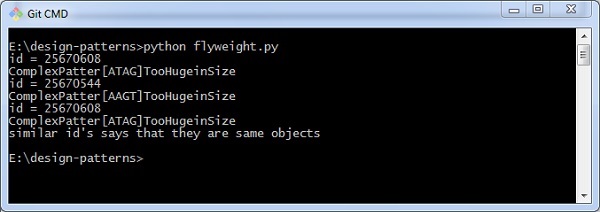
- Python Design Patterns Tutorial
- Python Design Patterns - Home
- Introduction
- Python Design Patterns - Gist
- Model View Controller Pattern
- Python Design Patterns - Singleton
- Python Design Patterns - Factory
- Python Design Patterns - Builder
- Python Design Patterns - Prototype
- Python Design Patterns - Facade
- Python Design Patterns - Command
- Python Design Patterns - Adapter
- Python Design Patterns - Decorator
- Python Design Patterns - Proxy
- Chain of Responsibility Pattern
- Python Design Patterns - Observer
- Python Design Patterns - State
- Python Design Patterns - Strategy
- Python Design Patterns - Template
- Python Design Patterns - Flyweight
- Abstract Factory
- Object Oriented
- Object Oriented Concepts Implementation
- Python Design Patterns - Iterator
- Dictionaries
- Lists Data Structure
- Python Design Patterns - Sets
- Python Design Patterns - Queues
- Strings & Serialization
- Concurrency in Python
- Python Design Patterns - Anti
- Exception Handling
- Python Design Patterns Resources
- Quick Guide
- Python Design Patterns - Resources
- Discussions
Python Design Patterns - Flyweight
The flyweight patterb comes under the structural design patterns category. It provides a way to decrease object count. It includes various features that help in improving application structure. The most important feature of the flyweight objects is immutable. This means that they cannot be modified once constructed. The pattern uses a HashMap to store reference objects.
How to implement the flyweight pattern?
The following program helps in implementing the flyweight pattern −
class ComplexGenetics(object):
def __init__(self):
pass
def genes(self, gene_code):
return "ComplexPatter[%s]TooHugeinSize" % (gene_code)
class Families(object):
family = {}
def __new__(cls, name, family_id):
try:
id = cls.family[family_id]
except KeyError:
id = object.__new__(cls)
cls.family[family_id] = id
return id
def set_genetic_info(self, genetic_info):
cg = ComplexGenetics()
self.genetic_info = cg.genes(genetic_info)
def get_genetic_info(self):
return (self.genetic_info)
def test():
data = (('a', 1, 'ATAG'), ('a', 2, 'AAGT'), ('b', 1, 'ATAG'))
family_objects = []
for i in data:
obj = Families(i[0], i[1])
obj.set_genetic_info(i[2])
family_objects.append(obj)
for i in family_objects:
print "id = " + str(id(i))
print i.get_genetic_info()
print "similar id's says that they are same objects "
if __name__ == '__main__':
test()
Output
The above program generates the following output −

Advertisements